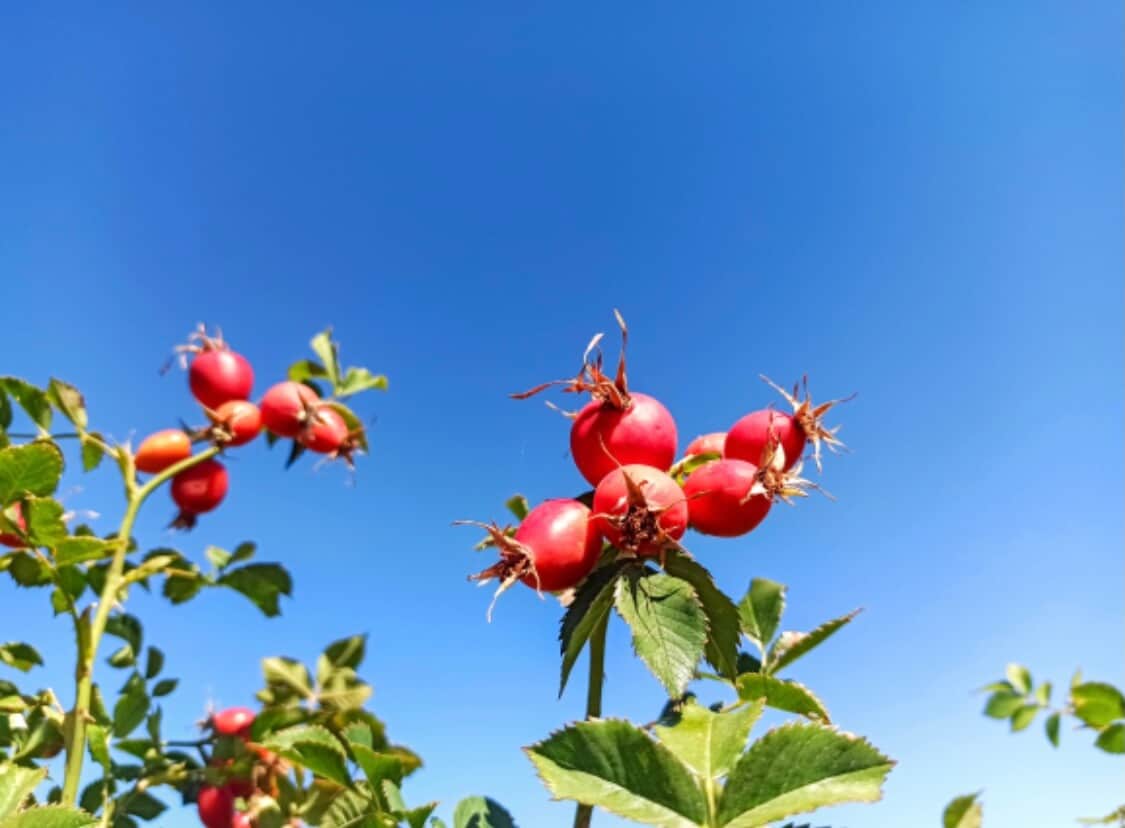Have you ever noticed the tangle of wild roses growing along tree lines or among the hedgerows? Come late summer or early fall, the petals fade away and leave behind beautiful jewel-like fruits hidden in the thorny interior.
There are what are called rose hips. Rose hips range in size and shape and their colors pop from shades of ruby red to deep purple. These are one of my favorite things to forage for myself and my animals! I am conscious to not be greedy and to only take what I need to use fresh or to preserve for later use.

I am excited when I first notice the rose hips forming – starting out green and unassuming. I keep an eye on them because I know that once they are ripe I will end up competing with the birds and other wildlife.
My goats and horses sound their anticipation in bleats and whinnies for the rose hips when they see me get out my bucket, ladder, and sheers. The rabbits love munching on them too. And, my dog has been known to steal clusters of rose hips from the bucket when she thinks I’m not looking.
Whether domesticated or wild, I love the innate sense that animals were created with to know what is good and beneficial for their bodies. We could definitely learn a thing or two from them, if we simply allow them to be our teachers.
So, what is so beneficial about rose hips?
This simple little seed pod is packed full of vitamin c, vitamin e, and other amazing antioxidants. This means it supports the immune system so that it stays strong and healthy, promotes good circulation, and reduces inflammation in the body. Research also shows that it helps with arthritis, reducing pain and improving physical functions. In other studies, rose hips have been noted to give relief to individuals struggling with gastrointestinal issues and reduced diabetic symptoms in rats.
For its size, the rose hips is quite the powerhouse and shouldn’t be overlooked!
Though rose hips are best fed fresh, I also save some for the winter months for any of my animals who may be feeling under the weather. To preserve them, I either simply freeze the fruits and thaw them out when I want to use them or I blend them together with apple cider vinegar and elderberries for a “sickness-kicking smoothie”.
Rose hips can also be turned into jam, jelly, sauces, syrups, and tea for us to enjoy!
These truly are a treasure among the thorns.
Please note: if you are on medication, make sure to do your research before taking rose hips or anything that contains rose hips.
Resources:
https://www.thespruce.com/what-are-rose-hips-and-what-do-they-do-1403046
https://www.verywellhealth.com/the-benefits-of-rose-hip-89506
______________
Written by: Emily Bradburn
Emily Bradburn is a writer, entrepreneur, self publisher, and owner of The Healthy Home & Herd Magazine. Being raised on a hobby farm gave Emily her passion for animals, gardening, foraging, and the great outdoors. When she isn’t writing or spending time with her various pets, Emily enjoys photography, making homemade natural skin care products, and binge watching Netflix. To learn more about The Healthy Home & Herd magazine, you can follow Emily on Instagram: triplehmagazine.
Many of our readers find that subscribing to Eat The Planet is the best way to make sure they don't miss any of our valuable information about wild edibles.
See our privacy policy for more information about ads on this site






